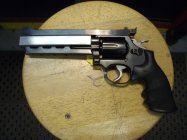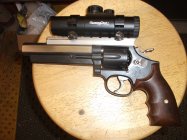I certainly don't feel "the need" to learn about S&W revolvers on Utube, as I am Ron Power trained, and a gunsmith school grad (MCC, class of '93), where S&W was well covered in "Advanced Repair". On 2 S&W revolvers we were required : install oversized hand and time, install and fit DA sear for proper function, and install OS cylinder stop. That is all hand fitting.
View attachment 1466506We straightened the yoke where the cylinder rides for alinement between firing pin and barrel, and peened and fit the end that goes in the frame to tighten yoke to frame fit,,,, along with smoothing and tuning. The Ron Power classes were more about tuning and fitting custom thread and forcing cone PPC barrels from a blank, make an underlug from bar stock and fit the 'ball lock'. The pic is of tools from my S&W tool box, not one I 'pulled' off the web, somewhere.
Back in the 1970’s, I built the revolvers for the Houston Texas PPC team, that being Police Proficiency Competition Matches.
I took generic Model 10 38’s, installed a flat sided custom 6 inch barrel, (I bought Shilen blanks and did all of the machine work), removed all of the single action function including the hammer spur, polished all of the internals, got the spring tensions correct, timed them, and mounted a Bomar Rib on top.
Shooting 148 grn wadcutters at 750 fps, these pistols would place 6 shots inside an inch when fired in a Ransom Rest at 25 yards.
My crowning achievement was my “45 magnum” built on a N frame. I gained around .040 diameter cylinder clearance by dressing and squaring the inside of the frame. With the help of a Metallurgist, Mr. Korny Smith at Jorgensen Steel, I acquired a piece of Premium Aircraft Quality E4340..
He had the piece normalized and annealed. I then roughed out the cylinder, and Mr Smith had the final heat treating performed. He had it hardenned, then the temper drawn on two steps for a final RC hardness of 38.
I then did all of the finished machining.
I used a Model 28 as a start, you could buy them back then for less than $200 with the police discount.
I did all of my action tricks, and used a Model 25 6 1/2 inch barrel.
This is truly a one of a kind. The pistol was the feature article in July 1978 Guns and Ammo, where shooting editor Howard Glaze declared it the finest Smith he ever shot.
here is the pistol I haven’t shot it in a while. My favorite load was a 250 grn hard cast Keith
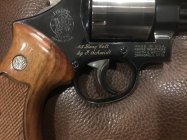
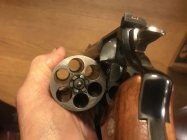
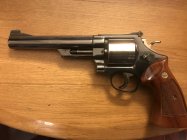
Semi Wadcutter with enough Blue Dot to push it to 1275 fps.












